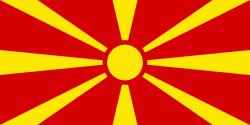Vaksince
Vaksince (Ваксинце, Vaksincë) is a village in the municipality of Lipkovo, North Macedonia.
Ottoman Empire, Serbia, Yugoslavia, North Macedonia
Vaksince, like the whole region of Macedonia, belonged to the Ottoman Empire for centuries. When it fell apart at the beginning of the 20th century, Albania gained independence on November 28, 1912, during which the majority of citizens in and around Vaksince were in favor of their region belonging to this new state. However, Serbia was able to persuade the great powers that most of the Albanian settlement areas in Macedonia came under its rule, including Vaksince. Between 1918 and 1991 Vaksince belonged to Yugoslavia and since then to North Macedonia (until 2019 Republic of Macedonia).
The Macedonian-Albanian conflict in 2001
Location of Vaksinces within the 2001 conflict zones
In 2001, Vaksince was one of the scenes of the Albanian Uprising in Macedonia. The place gained notoriety beyond the borders of the Republic of Macedonia because strong armed clashes between the Albanian insurgents, who belonged to the NLA, and the Macedonian army took place here in May of that year. Albanian fighters killed two Macedonian soldiers and captured a third near the village. The Macedonian army then attacked Vaksince with attack helicopters and artillery fire. The Macedonian troops managed to shoot the commander of the Albanian insurgents, Fadil Nimani. After that, the shelling of the place was stopped.
Overall, several Albanian civilians, two NLA fighters and several Macedonian soldiers and police officers lost their lives in the clashes over Vaksince. The two Albanian parties in Macedonia condemned the actions of the NLA and the threat to Albanian civilians from the army's artillery fire.
Vaksince, like other places in the region, was then closely monitored by the international missions of the OSCE, NATO and the EU. The Macedonian army and police had no control over Vaksince at times even after the clashes. In autumn 2003 the village was occupied again by the Macedonian army.
To this day there are many Albanians in the region who want to join Kosovo. In September 2007 there was a shootout between former NLA fighters and the Macedonian police. Two people were killed, including the commander of the regional police.
Ottoman Empire, Serbia, Yugoslavia, North Macedonia
Vaksince, like the whole region of Macedonia, belonged to the Ottoman Empire for centuries. When it fell apart at the beginning of the 20th century, Albania gained independence on November 28, 1912, during which the majority of citizens in and around Vaksince were in favor of their region belonging to this new state. However, Serbia was able to persuade the great powers that most of the Albanian settlement areas in Macedonia came under its rule, including Vaksince. Between 1918 and 1991 Vaksince belonged to Yugoslavia and since then to North Macedonia (until 2019 Republic of Macedonia).
The Macedonian-Albanian conflict in 2001
Location of Vaksinces within the 2001 conflict zones
In 2001, Vaksince was one of the scenes of the Albanian Uprising in Macedonia. The place gained notoriety beyond the borders of the Republic of Macedonia because strong armed clashes between the Albanian insurgents, who belonged to the NLA, and the Macedonian army took place here in May of that year. Albanian fighters killed two Macedonian soldiers and captured a third near the village. The Macedonian army then attacked Vaksince with attack helicopters and artillery fire. The Macedonian troops managed to shoot the commander of the Albanian insurgents, Fadil Nimani. After that, the shelling of the place was stopped.
Overall, several Albanian civilians, two NLA fighters and several Macedonian soldiers and police officers lost their lives in the clashes over Vaksince. The two Albanian parties in Macedonia condemned the actions of the NLA and the threat to Albanian civilians from the army's artillery fire.
Vaksince, like other places in the region, was then closely monitored by the international missions of the OSCE, NATO and the EU. The Macedonian army and police had no control over Vaksince at times even after the clashes. In autumn 2003 the village was occupied again by the Macedonian army.
To this day there are many Albanians in the region who want to join Kosovo. In September 2007 there was a shootout between former NLA fighters and the Macedonian police. Two people were killed, including the commander of the regional police.
Map - Vaksince
Map
Country - Republic_of_Macedonia
 |
 |
The region's history begins with the kingdom of Paeonia, a mixed Thraco-Illyrian polity. In the late sixth century BC, the area was subjugated by the Persian Achaemenid Empire, then incorporated into the Kingdom of Macedonia in the fourth century BC. The Roman Republic conquered the region in the second century BC and made it part of the larger province of Macedonia. The area remained part of the Byzantine Empire, but was often raided and settled by Slavic tribes beginning in the sixth century of the Christian era. Following centuries of contention between the Bulgarian, Byzantine, and Serbian Empires, it was part of the Ottoman Empire from the mid-14th until the early 20th century, when, following the Balkan Wars of 1912 and 1913, the modern territory of North Macedonia came under Serbian rule.
Currency / Language
| ISO | Currency | Symbol | Significant figures |
|---|---|---|---|
| MKD | Macedonian denar | ден | 2 |
| ISO | Language |
|---|---|
| SQ | Albanian language |
| MK | Macedonian language |
| SR | Serbian language |
| TR | Turkish language |















